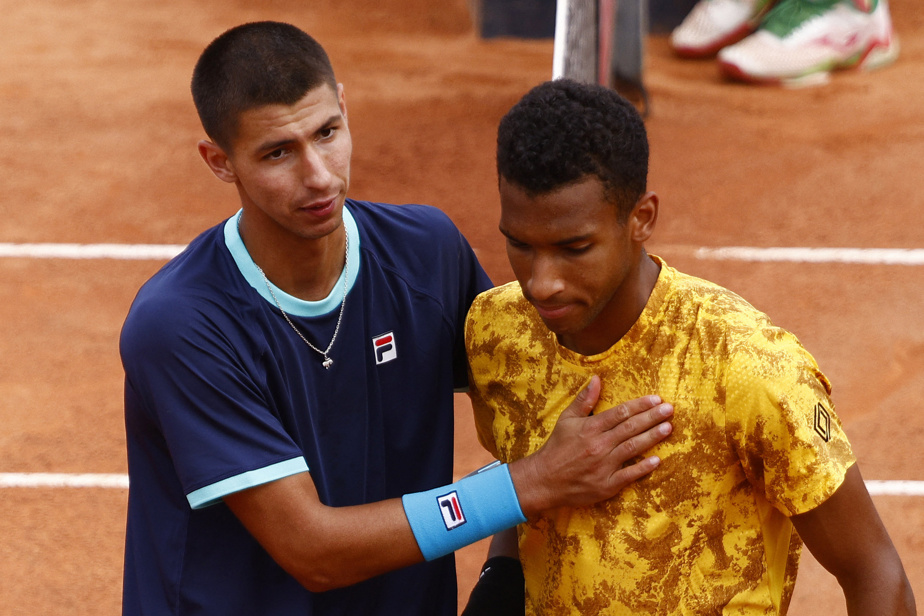It’s not going well for Canadian players this season. Even less on clay. However, a few years ago, thanks to the national center, it was possible to believe in a possible authority of the players here during important tournaments played on red sand.
Undoubtedly destined to skirt the tables of the most prestigious appointments, the Canadians have been crawling more than they have been standing for months.
Whether they are pushed by the wind or the simple ambition to continue their momentum at the end of the season, the representatives of the maple leaf show up at the Porte d’Auteuil with little rhythm, a minimum of momentum and very little trust.
Among the men, Félix Auger-Aliassime had to miss almost a month of activity to treat a knee injury. Last week, he withdrew from the Lyon tournament due to shoulder problems. The Quebecer has lost two of his three matches on clay in 2023.

PHOTO GUGLIELMO MANGIAPANE, REUTERS ARCHIVES
Felix Auger-Aliassime and Alexei Popyrin in Rome
However, barely a year ago, at this date, he had given Novak Djokovic and Rafael Nadal a hard time, in Rome and at Roland-Garros.
There was a time when the prowess of Auger-Aliassime on clay suggested a possible mastery of this surface which belongs more to Europeans. Especially since Tennis Canada’s national center in Montreal had innovated with the addition of clay courts at the IGA stadium.
A few days before another Roland-Garros, the prophecy has not yet come true.
According to Robby Ménard, coach, advanced statistics specialist and analyst, “on clay, his serve loses some of its effectiveness”.
However, he mostly mentions his knee injury. On a surface as unforgivable as clay, Auger-Aliassime’s physical condition could explain part of his failure. “His movements are a little less precise, so he makes unforced errors. And on clay, your footwork becomes key. Félix is a little less good at the moment in footwork. […] As soon as it is ready, it will become solid again. »
The other flaw in the game of 10e world racket lies in his match starts. In his last 10 games, the 22-year-old has lost the first set five times. The other five times he had to win seven games to win the set. “He improves in the second part of the matches, so there is also the psychological effect, but it’s not worrying, because he is good in the second parts of the match,” continues Ménard.
A matter of DNA
It’s not going much better for his compatriots these days.
Denis Shapovalov has lost two of his three matches on clay. Bianca Andreescu is zero in two. Leylah Annie Fernandez stands out, with five wins in 10 games, but in smaller tournaments.
For Ménard, this lethargy on clay is explained by the DNA of the players. Even if the athletes are gradually becoming more versatile and Tennis Canada has given itself the means to fulfill its ambitions, a player can never deny his inner nature.
“When you compile stats, you realize that the DNA of the player will always remain the DNA of the player,” he says of the young athletes aged 11 to 15 for whom he is responsible for development.
Currently, Canadian players do not have the tennis DNA necessary to dominate on clay. “That doesn’t mean that a Canadian could never have the DNA of a clay court player. That doesn’t mean a guy from Spain won’t have an attacking game. Each type of player is molded to a surface. »

PHOTO CLIVE BRUNSKILL, REUTERS ARCHIVES
Milos Raonic
He gives the example of Milos Raonic, whose style of play blends perfectly with grass surfaces. Or the counter-example of Shapovalov, who is imperfect on clay, because his game is not doing well there. This is why he never reached the third round at Roland-Garros.
During the interview, Ménard explained about Auger-Aliassime that “even if he is not playing well at Roland-Garros, he just has to come back in good physical shape. When you have a knee problem and you are no longer able to move, you start your matches badly, because you are careful”.
This analysis also applies to Bianca Andreescu, who suffered an ankle injury just a few weeks ago.
It would be ambitious to bet a penny on the Canadians at Roland-Garros, but as the group is still very young, optimism is still in order for the rest of the season and for years to come.
